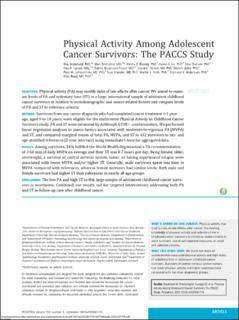| dc.contributor.author | Grydeland, May | |
| dc.contributor.author | Bratteteig, Mari | |
| dc.contributor.author | Rüegg, Corina Silvia | |
| dc.contributor.author | Lie, Hanne Cathrine | |
| dc.contributor.author | Thorsen, Lene | |
| dc.contributor.author | Larsen, Elna Hamilton | |
| dc.contributor.author | Brügmann-Pieper, Sabine Kristin | |
| dc.contributor.author | Torsvik, Ingrid Kristin | |
| dc.contributor.author | Götte, Miriam | |
| dc.contributor.author | Lähteenmäki, Päivi Maria | |
| dc.contributor.author | Kriemler, Susi | |
| dc.contributor.author | Fridh, Martin Kaj | |
| dc.contributor.author | Anderssen, Sigmund Alfred | |
| dc.contributor.author | Ruud, Ellen | |
| dc.date.accessioned | 2023-10-24T08:06:51Z | |
| dc.date.available | 2023-10-24T08:06:51Z | |
| dc.date.created | 2023-09-05T12:54:11Z | |
| dc.date.issued | 2023 | |
| dc.identifier.citation | Pediatrics. 2023, 152(3), Artikkel e2023061778. | en_US |
| dc.identifier.issn | 0031-4005 | |
| dc.identifier.uri | https://hdl.handle.net/11250/3098245 | |
| dc.description | This is an open access article distributed under the terms of the Creative Commons Attribution-NonCommercial-NoDerivatives 4.0 International License (https://creativecommons.org/licenses/by-nc-nd/4.0/), which permits noncommercial, distribution, and reproduction in any medium, provided the original author and source are credited. | en_US |
| dc.description.abstract | Objectives: Physical activity (PA) may modify risks of late effects after cancer. We aimed to examine levels of PA and sedentary time (ST) in a large, international sample of adolescent childhood cancer survivors in relation to sociodemographic and cancer-related factors and compare levels of PA and ST to reference cohorts.
Methods: Survivors from any cancer diagnosis who had completed cancer treatment ≥1 year ago, aged 9 to 16 years, were eligible for the multicenter Physical Activity in Childhood Cancer Survivors study. PA and ST were measured by ActiGraph GT3X+ accelerometers. We performed linear regression analyses to assess factors associated with moderate-to-vigorous PA (MVPA) and ST, and compared marginal means of total PA, MVPA, and ST in 432 survivors to sex- and age-stratified references (2-year intervals) using immediate t-tests for aggregated data.
Results: Among survivors, 34% fulfilled the World Health Organization’s PA recommendation of ≥60 min of daily MVPA on average and their ST was 8.7 hours per day. Being female, older, overweight, a survivor of central nervous system tumor, or having experienced relapse were associated with lower MVPA and/or higher ST. Generally, male survivors spent less time in MVPA compared with references, whereas female survivors had similar levels. Both male and female survivors had higher ST than references in nearly all age groups.
Conclusions: The low PA and high ST in this large sample of adolescent childhood cancer survivors is worrisome. Combined, our results call for targeted interventions addressing both PA and ST in follow-up care after childhood cancer. | en_US |
| dc.language.iso | eng | en_US |
| dc.subject | accelerometers | en_US |
| dc.subject | cancer | en_US |
| dc.subject | central nervous system neoplasms | en_US |
| dc.subject | childhood cancer survivors | en_US |
| dc.subject | lack of exercise | en_US |
| dc.subject | moderate to vigorous physical activity | en_US |
| dc.subject | overweight | en_US |
| dc.subject | physical activity | en_US |
| dc.subject | survivors | en_US |
| dc.title | Physical activity among adolescent cancer survivors: The PACCS study | en_US |
| dc.type | Peer reviewed | en_US |
| dc.type | Journal article | en_US |
| dc.description.version | publishedVersion | en_US |
| dc.rights.holder | © 2023 American Academy of Pediatrics | en_US |
| dc.source.pagenumber | 13 | en_US |
| dc.source.volume | 152 | en_US |
| dc.source.journal | Pediatrics | en_US |
| dc.source.issue | 3 | en_US |
| dc.identifier.doi | 10.1542/peds.2023-061778 | |
| dc.identifier.cristin | 2172512 | |
| dc.description.localcode | Institutt for fysisk prestasjonsevne / Department of Physical Performance | en_US |
| dc.description.localcode | Institutt for idrettsmedisinske fag / Department of Sports Medicine | en_US |
| dc.source.articlenumber | e2023061778 | en_US |
| cristin.ispublished | true | |
| cristin.fulltext | original | |
| cristin.qualitycode | 2 | |

